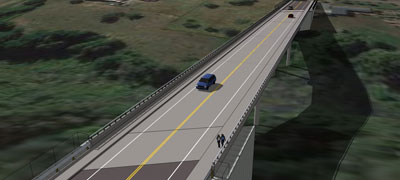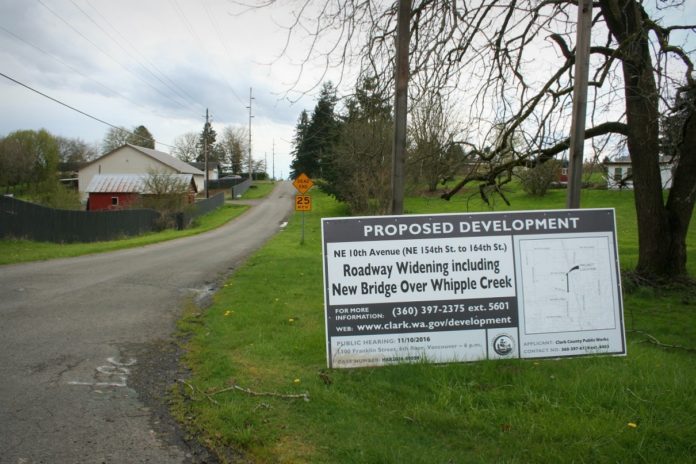The construction bid on the much-anticipated widening and extension of NE 10th Avenue near the Clark County Fairgrounds was awarded this week to Cascade Bridge LLC of Vancouver. With a Fall 2018 completion goal, the project is expected to open the area west of I-5 to commercial and industrial development as well as improve access for emergency responders.
Part of a multi-phase transportation plan, County Manager Mark McCauley applauded the Clark County Public Works department for their clear vision and execution of the Salmon Creek Interchange Project and the Salmon Creek Park & Ride relocation.
Both of these projects included the widening and improvement of adjacent county roads with attention to add bicycle lanes and pedestrian sidewalks, where prudent, to promote multimodal transportation. This approach to support the long-term Clark County Bicycle and Pedestrian Master Plan will also play a significant role in the two-phase NE 10th Avenue expansion.
Located along the Discovery Corridor, the section of NE 10th Avenue from NE 154th to NE 164th streets will take precedent, followed up by the NE 149th to NE 154th streets expanse, hopefully, in 2020.
McCauley noted the alleviation of congestion around the Clark County Event Center and Sunlight Supply-Clark County Amphitheater as an identified need. These facilities can draw as many as 18,000 to 20,000 people for an attraction. Completing NE 10th Avenue will enable half of the traffic to be diverted southbound and the other half to continue to enter and exit from the north.

Although John Morrison, CEO of the Clark County Event Center, still sees event goers using the 179th Street exit as their entry point, he agreed that the extension of 10th Avenue will be a “major improvement.”
“The exit piece, in terms of time, will be felt immediately. People can turn right (onto NE 10th Avenue) and head straight down to Salmon Creek,” Morrison said.
To encourage commercial development, sewer and electrical will be extended up north where now only septic exists and storm water treatment facilities will be installed. Other key features are a center-turn lane for the entire expanse, with the exception of the Whipple Creek Bridge; bicycle-pedestrian amenities; and 10th Avenue being a through street with no signals.
The bridge itself will be a unique engineering feature for Clark County. Jean Singer, capital project manager for Clark County, described the greatest challenge of the undertaking.
“Whipple Creek is a sensitive area with environmental species [and] nature,” said Singer. “[It’s a] habitat corridor with special conditions. That being said, it’s a very long span. We had to come up with a design that minimized its environmental impacts.”
According to Singer, the bridge will be 450 feet in length, anchored by two 120-foot concrete walls on either side. The crowning 210-foot center span will be supported by weathering steel which will give it a patina look as it ages to better blend with its surroundings. She further stated that most of the current bridges in Clark County are from 60 to 100 feet long with no bike lanes or sidewalks, making Whipple Creek “significant” for their inventory. Great thought went into how the County would access and maintain the structure for the next 75 to 100 years.
Another plan being supported by this project is the Clark Regional Comprehensive Emergency Management Plan. McCauley shared that the Clark County Fairgrounds and Event Center serves as a site for disaster recovery and response in the event of a large scale incident. Currently, the only clear access point to the Event Center is under the 179th Street interchange. If that interchange were to collapse, it would significantly hinder entry for emergency responders.
Keeping that focus top of mind, the envisioned Whipple Creek Bridge will employ state-of-the-art considerations.
Troy Pierce, project manager, said “The bridge is designed for the 1,000-year seismic event, which includes the effects from a Cascadia Subduction Zone event. A number of design elements have been included.”
He went on to site soil preparation taking into account ground shifting during and after a significant seismic event; an integral abutment approach which maintains connection between the bridge superstructure and substructure to promote movement as a continuous span rather than stand-alone sections; and continuous steel girders in lieu of simple span girders will further support the integral abutment concept.
Brent Grening, Port of Ridgefield CEO, weighed in on yet another benefit of connecting the entire Discovery Corridor. He sees linking several entertainment and recreational centers – from the fairgrounds and amphitheater to the ilani Casino, Tri-Mountain Golf Course, Ridgefield National Wildlife Refuge and North County wineries – as supporting a rapidly-emerging visitor and tourism industry.
Grening went on to point out that the NE 10th Avenue project will enhance traffic circulation as more residential growth pushes north and complement job growth, commercial and industrial land parallel to I-5.
“The connection will allow local trips to move without necessarily using I-5 as a local arterial. This is an important benefit, because the connection conserves capacity on I-5 for commuter and freight mobility at the regional level,” Grening said.
Since the139th Street interchange was completed in 2014, commercial and industrial zoning along 10th Avenue has become more accessible and desirable. This next phase will continue to support that direction and McCauley said the County is pleased to have the funding in place for a green light.
“It’s been a diamond in the rough and we’re going to cut the diamond and make it nice,” he said.






